That is actually the reason why I think this is the best way to take care of our horses, because we have to think and adapt to the very nature of each horse individuals. Basically, our goal when trimming our horses is the natural hoof! We should not treat the hoof as we want it to look like but as it is supposed to be naturally. “_ You will have to learn to read the hoof.
_ If you listen, the hoof itself will tell you everything you need to know.
Making Natural Hoof Care Work For You, Pete Ramey
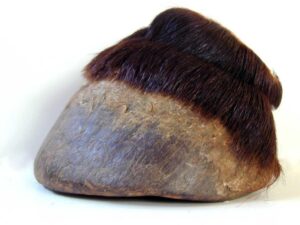
The objective of that article is not to cover all the Natural Trimming matters as it is way over my skills and is a wide subject. I want here to introduce you to the basics of natural trimming and demystify the idea that only accredited professionals should be able to (be paid to) touch our horses’ hooves.
 Settings
Settings
Prepare for success: find a location where the horse feels good, make sure you feel comfortable with the horse (and vice-versa), balance it before you ask for the hoof (and ask before you take the foot, see the video how to teach a horse to pick up its hooves if necessary), and handle it gently all the time.
Making Natural Hoof Care Work For You, Pete Ramey
Take your time: do not be too hasty when you nip, cut, rasp or trim as you do not want to harm the horse nor to do too much. On the other hand, do not try to force the hoof, you can trim step by step: you should be “aiming the direction of the wild model rather than hacking the hoof to it on day one.”
Natural trimming should never end with soreness. Horses you trim should always feel as good as before, or better of course as it is our purpose.
 Trimming
Trimming
Trimming is just a question of being well organized, to stick to the plan and take your time:
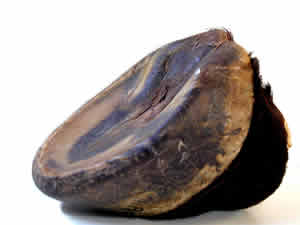
Read the hoof:
Imbalance, flaring, toe wall, heels length… “visualize the coffin bone” in the hoof capsule.
Frog/Sole juncture:
That is a very important marker as this juncture, the collateral grooves, is the “absolute limit of any trimming”. Beyond that limit, you may cut into live tissues and harm your horse. Trim away the frog’s flaps at about 45° to avoid any bacteria nest, then trim the frog at its apex until the juncture fades away. You can remove the sole in about 2 cm around the frog forward of the bars, but leave the rest of the sole. This way of trimming the sole will help the hoof to grow thick and concave, and the sole to harden. Solar concavity of the hoof is the natural dome that wild horses develop on rough terrain and that is our goal when trimming our horses, yet “solar concavity must be built, not cut.”
Sole callous:
We want to let as much sole as possible. The objective is to remove all dead sole, you can recognize it as it is powdery and flaky. Waxy sole is live sole and should be left alone. We will help the callous sole to receive as much passive wear as possible by:
- Making sure we never let excessive hoof wall build,
- Trimming the bars before they grow too long,
- Allowing plenty of movement.
Roughing out the hoof:
Once the dead sole is removed, trim the hoof wall all the way around. Use nippers if the wall is really long, knife or rasp should make it otherwise.
Heels and bars:
Making Natural Hoof Care Work For You, Pete Ramey
Distance from the coronet to the ground should be the same on each side of the hoof. Do not try to shorten the heels at the first trim, just cut them down step by step at each and every trim until the hoof finds the good length and maintain it (“Never cut the heels lower than the widest point of the frog”). Bars should be trimmed in a straight line down to the frog, along it and around the apex. Cut away any crack in the bars.
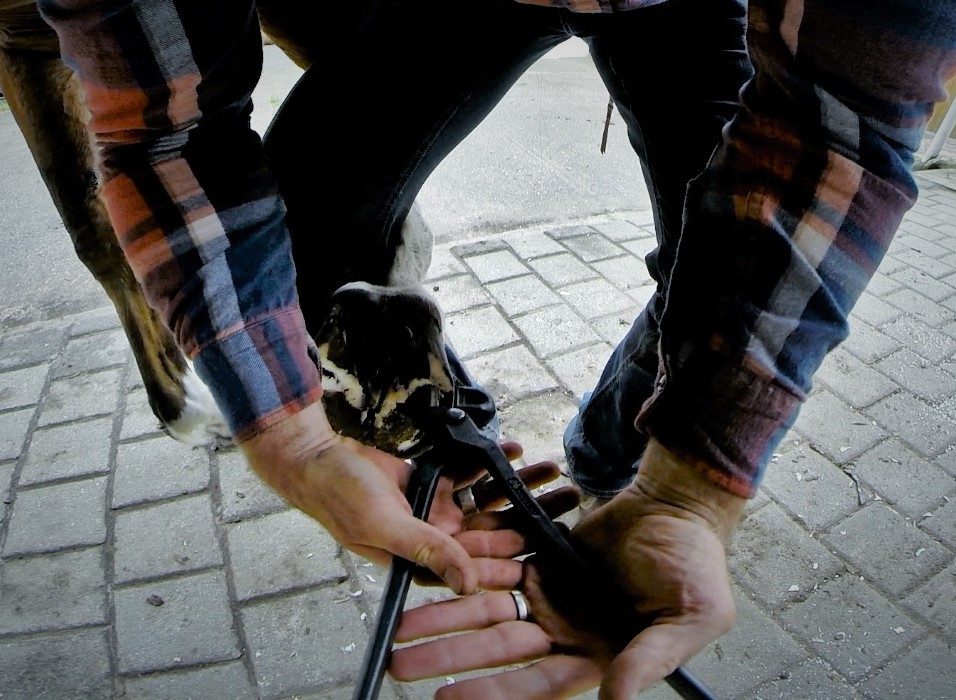
Toe:
Take a close look at the two centimeters of wall going down from the coronet. That is the angle the hoof tries to grow. Any change of that angle downward is a clear sign of a toe stretched forward. Do not touch the sole at the toe, but back it up to the white line with your nippers perpendicularly to the bottom of the hoof. This will stop the stretching of the laminae and should relieve the horse at once.
Quarters:
They should actually not touch the ground on a flat surface but be slightly hollowed out, like the palm of our feet. Hoof wall should remain 1 mm above the sole at the quarters to protect better the sole.
Hoof wall from the top:
It should grow straight down from the coronet. If not, rasp the excessive material away, all way down to the ground. Taking a look at the hoof from above, the “wall should be fairly parallel to the hairline all the way around”.
Mustang roll:
Even our domestic horses deserve the best, that mustang roll all around the hoof will prevent the wall to break or flare, moreover it will improve the horse’s locomotion as the hooves will get closer to their natural shape.
So, just keep the following in mind during your trimming:
1. Read the hoof
2. Trim the frog to the sole juncture
3. Build the sole callous
4. Rough out the hoof
5. Remove the bars and lower the heels
6. Back the toe up IF NECESSARY
7. Shape the quarters
8. Rasp the hoof wall straight down to the ground
9. Shape the Mustang roll
 Checking and helping
Checking and helping
Once the trimming is done, it is important to step back and take a look at the finished work. Make sure balance is correct and hooves are uniform (does not mean they are identical though). The hairline should be parallel to the ground when viewed from the front. Although we are not looking for a very specific and definitive angle, nature intended the hinds to be slightly steeper than the fronts.
Trimming phase is not all. Being consistent and regular is a key to maintain a good hoof before any damage occurs. Rehabilitation should be done once, then it is a just a matter of maintenance. Just like Natural Horsemanship prevents any disrespectful behavior, Natural Trimming _ when performed from the beginning with foals _ will prevent any hoof disease or malfunction. Finally, make sure you do all the necessary to be successful: diet should be well chosen (no sweet food for instance), environment should be in compliance with horses needs (lots of movements, dry ground, buddies to spend time with), etc.
As a conclusion, I would like to invite you all to consider a great book written by Pete Ramey: Making Natural Hoof Care Work for You. All the ideas of this article are extracted from this book. Pete Ramey was a “classic” farrier who had the opportunity to learn from Jaime Jackson, he then practiced over hundreds of horses and experienced great results. He has a non-marketing, empathetic way of approaching Natural Trimming and his explanations although technical sometimes are very intuitive.
I do think that we all, horse owners and riders, have the possibility to do more with our horses, including taking care of their hooves and trimming them. This article is written to invite those who still hesitate to grab their tools and do it... BUT, do not start to nip, cut, rasp, until you have studied enough. Reading Pete Ramey's book is a good beginning, take a look at videos on internet, read web sites and articles. Then, when you have acquired enough knowledge, give it a shot, you will not regret it.
 First trim example
First trim example
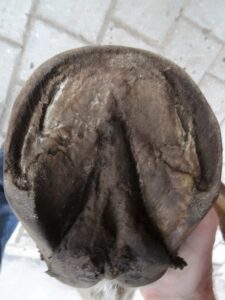
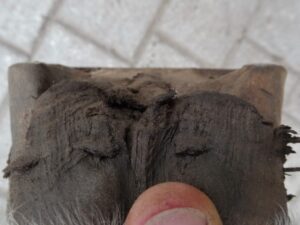
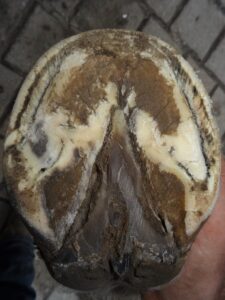
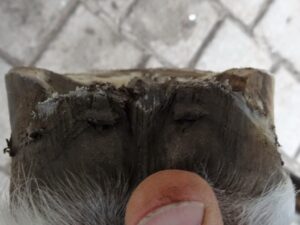
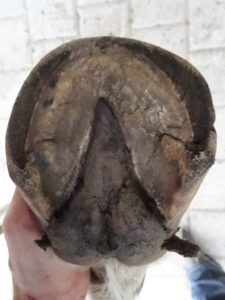
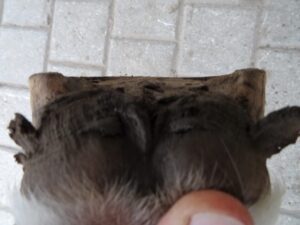
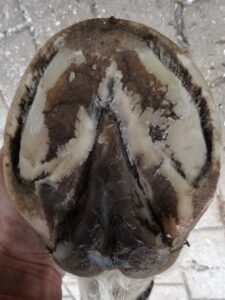
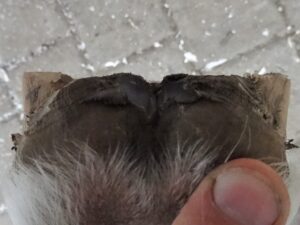
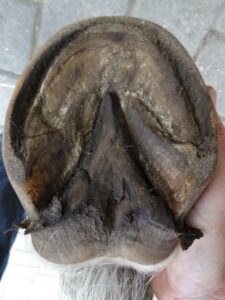
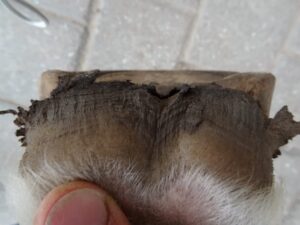
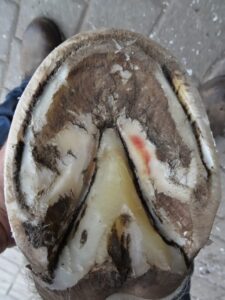
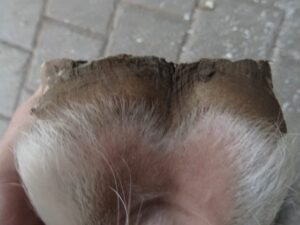
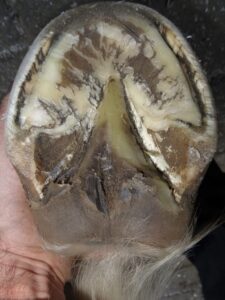
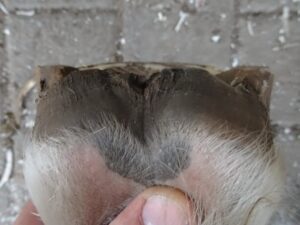
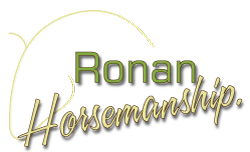
 ENGLISH
ENGLISH DEUTSCH
DEUTSCH ESPAÑOL
ESPAÑOL FRANÇAIS
FRANÇAIS